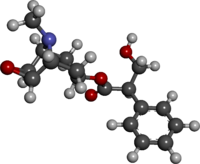Hyoscine
 |
|
 |
|
| Clinical data | |
|---|---|
| Trade names | Transdermscop, Kwells, others |
| AHFS/Drugs.com | Monograph |
| Pregnancy category |
|
| Routes of administration |
by mouth, skin patch, eye drops, subcutaneous, intravenous, sublingual, rectal, buccal transmucousal, intramuscular |
| ATC code | |
| Legal status | |
| Legal status | |
| Pharmacokinetic data | |
| Metabolism | Liver |
| Biological half-life | 4.5 hours |
| Excretion | Kidney |
| Identifiers | |
|
|
| Synonyms | hyoscine hydrobromide, scopolamine hydrobromide |
| CAS Number | |
| PubChem CID | |
| IUPHAR/BPS | |
| DrugBank | |
| ChemSpider | |
| UNII | |
| KEGG | |
| ChEBI | |
| ChEMBL | |
| ECHA InfoCard | 100.000.083 |
| Chemical and physical data | |
| Formula | C17H21NO4 |
| Molar mass | 303.353 g/mol |
| 3D model (Jmol) | |
|
|
|
|
|
|
|
Hyoscine, also known as scopolamine, is a medication used to treat motion sickness and postoperative nausea and vomiting. It is also sometimes used before surgery to decrease saliva. When used by injection effects begin after about 20 minutes and last for up to 8 hours. It may also be used by mouth and as a skin patch.
Common side effects include sleepiness, blurred vision, dilated pupils, and dry mouth. It is not recommended in people with glaucoma or bowel obstruction. It is unclear if use during pregnancy is safe; however, it appears to be safe during breastfeeding. Hyoscine is in the antimuscarinic family of medications and works by blocking some of the effects of acetylcholine within the nervous system.
Hyoscine was first written about in 1881 and came into medical use in 1947. It is on the World Health Organization's List of Essential Medicines, the most effective and safe medicines needed in a health system. Hyoscine is produced from plants of the nightshade family. The name "scopolamine" is derived from one type of nightshade known as Scopolia while "hyoscine" is from another type known as Hyoscyamus niger.
Hyoscine has a number of uses in medicine, where it is used to treat the following:
It is sometimes used as a premedication (especially to reduce respiratory tract secretions) to surgery, mostly commonly by injection.
...
Wikipedia
